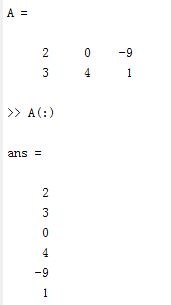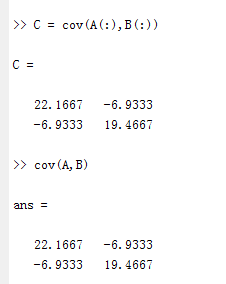【 MATLAB 】协方差 cov以及协方差矩阵基础知识
Covariance 翻译为协方差,因此,MATLAB里面的函数cov也就是求协方差了。至于MATLAB语言里面的协方差函数cov的语法是什么样的以及怎么用的,我们稍后再说,这里首先介绍下协方差相关的基础知识点。
本文内容参考自MATLAB的帮助手册,有的时候不得不说,数据手册才是最好的教材,不仅对于MATLAB,这里提供的都是原滋原味的官方内容。例如我经常去了解一些MATLAB中的相关函数,命令等,都可以通过MATLAB的数据手册;如果我想了解一些IP核以及与之相关的知识,我可以查看Xilinx的官方数据手册,内容应有尽有,相比而言,如果我去借一些书籍去查看FPGA的IP核,不仅版本陈旧,而已也有可能翻译的有问题,让人一知半解。
废话就说到这里,下面正式开始介绍。
目录
基础知识
协方差(Covariance):
协方差矩阵( covariance matrix):
矩阵的协方差:
方差:(这是赠送的)
MATLAB中的 cov
语法格式:
C = cov(A)
C = cov(A,B)
C = cov(___,w)
C = cov(___,nanflag)
示例
C = cov(A) 举例(矩阵的协方差)
cov(A,B) 举例之两个向量之间的协方差
cov(A,B) 举例之两个矩阵之间的协方差
Specify Normalization Weight
Covariance Excluding NaN
基础知识
协方差(Covariance):
对于两个随机变量向量A和B,那二者之间的协方差定义为:
其中![]() 表示向量A的均值,
表示向量A的均值,![]() 表示向量B的均值。
表示向量B的均值。
协方差矩阵( covariance matrix):
两个随机变量的协方差矩阵是每个变量之间成对协方差计算的矩阵,
矩阵的协方差:
对于矩阵A,其列各自是由观察组成的随机变量,协方差矩阵是每个列组合之间的成对协方差计算。 换一种说法
![]()
方差:(这是赠送的)
对于由N个标量观测组成的随机变量向量A,方差定义为
其中u是A的均值:
一些方差定义使用归一化因子N而不是N-1,可以通过将w设置为1来指定。在任何一种情况下,假设均值具有通常的归一化因子N.
(注意:w是后面要说的MATLAB里面的协方差函数的一个参数而已,在具体的MATLAB函数里面可以通过设置w来指定归一化因子!)
MATLAB中的 cov
语法格式:
下面逐个讲解:
C = cov(A)
C = cov(A)C = cov(A)
C = cov(A)返回协方差。
-
If
Ais a vector of observations,Cis the scalar-valued variance. -
如果A是一个观测向量,那么C是一个标量值的方差。
-
If
Ais a matrix whose columns represent random variables and whose rows represent observations,Cis the covariance matrix with the corresponding column variances along the diagonal. -
如果A是矩阵,其列表示随机变量,其行表示观测值,则C是协方差矩阵,沿对角线具有相应的列方差。(协方差矩阵的协方差是列的协方差值)
-
Cis normalized by the number of observations-1. If there is only one observation, it is normalized by 1. -
C由观察数-1归一化。 如果只有一个观察值,则将其标准化为1。
-
If
Ais a scalar,cov(A)returns0. IfAis an empty array,cov(A)returnsNaN. -
如果A是标量,则cov(A)返回0.如果A是空数组,则cov(A)返回NaN。
(你看看人家考虑的多周全!)
C = cov(A,B)
C = cov(A,B)C = cov(A,B)A and B.
C = cov(A,B)
-
If
AandBare vectors of observations with equal length,cov(A,B)is the2-by-2covariance matrix. -
如果A和B是同等长度的观测向量,那么C是一个2*2的协方差矩阵。
-
If
AandBare matrices of observations,cov(A,B)treatsAandBas vectors and is equivalent tocov(A(:),B(:)).AandBmust have equal size. -
如果A和B是观察矩阵,则cov(A,B)将A和B视为向量,并且等同于cov(A(:),B(:))。 A和B必须具有相同的大小。
-
If
AandBare scalars,cov(A,B)returns a2-by-2block of zeros. IfAandBare empty arrays,cov(A,B)returns a2-by-2block ofNaN. -
如果A和B是标量,则cov(A,B)返回2乘2的零块。 如果A和B是空数组,则cov(A,B)返回2乘2的NaN块。
C = cov(___,w)
C = cov(___,w)C = cov(___,w)w = 0 (default), C is normalized by the number of observations-1. When w = 1, it is normalized by the number of observations.
C = cov(___,w)指定任何先前语法的归一化权重。 当w = 0(默认值)时,C由观测数-1归一化。 当w = 1时,它通过观察次数归一化。
C = cov(___,nanflag)
C = cov(___,nanflag)C = cov(___,nanflag)NaN values from the calculation for any of the previous syntaxes. For example, cov(A,'omitrows') will omit any rows of A with one or more NaN elements.
C = cov(___,nanflag)指定从任何先前语法的计算中省略NaN值的条件。 例如,cov(A,'omitrows')将省略具有一个或多个NaN元素的A的任何行。
示例
下面举例说明重要的语法格式:
C = cov(A) 举例(矩阵的协方差)
Create a 3-by-4 matrix and compute its covariance
A = [5 0 3 7; 1 -5 7 3; 4 9 8 10];
C = cov(A)C = 4×4
4.3333 8.8333 -3.0000 5.6667
8.8333 50.3333 6.5000 24.1667
-3.0000 6.5000 7.0000 1.0000
5.6667 24.1667 1.0000 12.3333
Since the number of columns of A is 4, the result is a 4-by-4 matrix.
由于矩阵A有4列,表示有4个随机变量,那么协方差矩阵是4*4的。
cov(A,B) 举例之两个向量之间的协方差
1. Create two vectors and compute their 2-by-2 covariance matrix.
A = [3 6 4];
B = [7 12 -9];
cov(A,B)ans = 2×2
2.3333 6.8333
6.8333 120.3333cov(A,B) 举例之两个矩阵之间的协方差
2. Create two matrices of the same size and compute their 2-by-2 covariance.
A = [2 0 -9; 3 4 1];
B = [5 2 6; -4 4 9];
cov(A,B)ans = 2×2
22.1667 -6.9333
-6.9333 19.4667这相当于求A(:)和B(:)的协方差,如下验证下:
对比下cov(A,B)发现是一致的:
Specify Normalization Weight
创建一个矩阵并计算由行数归一化的协方差。
A = [1 3 -7; 3 9 2; -5 4 6];
C = cov(A,1)C = 3×3
11.5556 5.1111 -10.2222
5.1111 6.8889 5.2222
-10.2222 5.2222 29.5556我觉得还是有必要比较下不归一化的情况:
>> A = [1 3 -7; 3 9 2; -5 4 6]
A =
1 3 -7
3 9 2
-5 4 6
>> C = cov(A,1)
C =
11.5556 5.1111 -10.2222
5.1111 6.8889 5.2222
-10.2222 5.2222 29.5556
>> C = cov(A)
C =
17.3333 7.6667 -15.3333
7.6667 10.3333 7.8333
-15.3333 7.8333 44.3333
Covariance Excluding NaN
创建矩阵并计算其协方差,排除包含NaN值的任何行。
A = [1.77 -0.005 3.98; NaN -2.95 NaN; 2.54 0.19 1.01]A = 3×3
1.7700 -0.0050 3.9800
NaN -2.9500 NaN
2.5400 0.1900 1.0100
C = cov(A,'omitrows')C = 3×3
0.2964 0.0751 -1.1435
0.0751 0.0190 -0.2896
-1.1435 -0.2896 4.4104








